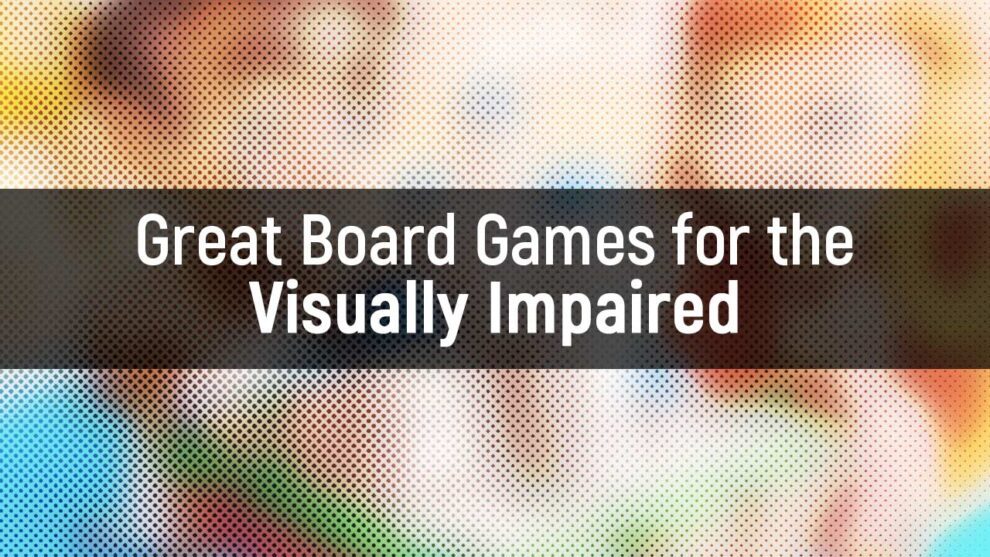Board games have long been a source of entertainment, strategy, and social interaction. And thanks to a world that’s growing increasingly inclusive, game designers and players now recognize the importance of adapting board games to cater to those with different visual needs. Developments in adaptive tech for gaming are now able to add interactivity and touch detection to boost all players’ engagement, enjoyment, and social connectivity — regardless of visual ability.
From blindness to color blindness and low vision, here’s a quick look at how games can be tailored to accommodate various impairments, followed by a closer look at four exceptionally accessible board games.
Adapting for Visual Impairments
Visual impairments cover a broad spectrum. To make board games accessible, one must understand the different ways that games can be adapted to accommodate them, a few of which we discuss below.
Blindness
Board games can be made accessible for individuals with blindness through several creative adaptations. By incorporating sound and touch, board game designers can better include blind players.
Color Blindness
Game designers can make games more accessible by implementing colorblind-friendly design principles. Using unique symbols or patterns alongside colors ensures players can differentiate game elements regardless of color perception. Otherwise, people with color blindness can also choose to wear tinted glasses while playing to better differentiate between shades of red and green or other types of color blindness.
Low Vision
For board game enthusiasts with low vision, there are various strategies to enhance their gameplay experience. With a thorough eye exam, updated prescription glasses can significantly improve the ability to read text and see the game board. These can come in single-vision or progressive lenses to cater to people needing near and far-away vision. Otherwise, opting for games with large text and bold, high-contrast visuals can help.
Accessible Board Games for Everyone
Below are four board games that stand out for their adaptability and accessibility.
No Thanks
No Thanks is a favorite in our household. A simple card game with a thin deck of cards, and a pile of chips. And yet, the delight and the agony that come with it is wonderful. The goal of each game is to wind up with the fewest points. On your turn your choice is to simply take the current card, or to pass by sliding a chip into the pot…and then it’s the next player’s turn. Eventually someone will either choose to take the card—and all the chips in the pot—or be forced to take the card because they have no more chips.
The key to No Thanks is taking the right cards as you only earn points for the lowest card in a run. For example if you have an 11 and a 13 in front of you, you have 2 “single-card runs” which equals 24 points at the end of the game. But if you’re able to take the 12, then you now only have a single 3-card run, and will receive 11 points. And in a devious twist you set aside a number of cards at the beginning of each game, so you’ll never know whether the 12 is even in the deck.
While blind players might have trouble with No Thanks, players with low vision issues will be delighted at the large-print numbers in the center of each card, along with the corners. And because No Thanks doesn’t rely on color, colorblind players should also have no issues with the game.
Santorini
2016’s Santorini is a delight for adults and children alike. Riding high on the wave of Greek mythology thanks to Rick Riordan’s Percy Jackson series, Santorini combined abstract movement games like chess or checkers, with modern board gaming concepts like variable player abilities. In Santorini players have two actions on their turn: move one of their 2 workers and build in an adjacent space. You win the game by either maneuvering one of your workers to the 3rd level of a tower, or by accomplishing the special ability of the god card you began the game with.
In true modern board game fashion Santorini has a deck of “god cards”, each with a unique and “rule breaking” ability. Some allow you to move additional spaces, or to build towers in specific ways, or even to use the special ability of their opponent’s god card.
Santorini has almost no reliance on color, with the exception of the player pieces. But those should be easily discernible, even to colorblind players. If necessary the player pieces can be replaced with any other similar sized pieces, which could even allow fully blind players to play the game. Towers are all white, except for the top domes which are blue. God cards are colorful, and almost without text, and the iconography at the bottom to indicate special abilities has good contrast against the background.
Nyctophobia
Meaning “fear of the dark”, the game Nyctophobia was literally designed by a college student to play with her blind uncle. Nyctophobia is a “one vs many” survival horror game in which one group of players wear blackout glasses and must escape from the forest without being caught by the remaining player (which is sighted).
In interviews with Catherine Stippell she indicates that she was inspired to design Nyctophobia after being unable to play other games with her uncle without heavy modifications.
As you might guess Nyctophobia has many tactile enhancements to make the game better for players with visual impairments. Every player piece has a unique shape embedded in the bottom, the 8×8 space board has deep wells for the placement of maze pieces, cardboard pieces are differently sized and shaped to make differentiating them easier. While a sighted person is required to set up, teach, and reference cards, the other players have no such restrictions and are free to enjoy the game with their friends and family.
Forbidden Island
Forbidden Island is a family weight cooperative game in which players must travel around a slowly sinking island, collecting relics, in order to escape by helicopter. It’s an excellent introduction to the cooperative genre, and one I recommend to any player.
For the most part Forbidden Island is a great game for players with visual disabilities. It’s cooperative, which means players are encouraged to help each other and work together, including personal cards, which can simply be placed face up. Most cards have either no to little text, and make heavy use of large and clear iconography. The only issues colorblind players might encounter is that the player pieces can be difficult to tell apart. But that’s easy to adjust by either marking the pieces or swapping them out for ones which are distinct.
Everyone Belongs at the Table
The board gaming world has become richer and more diverse, reflecting the inclusive nature and values of board gaming itself. Thank you to everyone who works tirelessly to make tabletop gaming more accessible to everyone.














I had a customer come into work about a year ago, who was near-legally blind. She was looking for games she could play with her grandson. One of the games she got, which worked very well, was YINSH. They had to do a little arts & crafts beforehand, thickening all the lines with a permanent marker, but the white and black pieces are high-contrast and make it easy to see what’s going on after you thicken the lines up a bit.